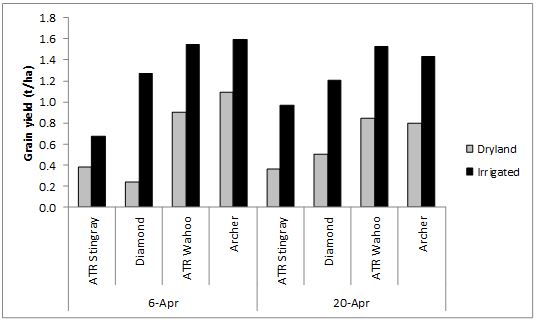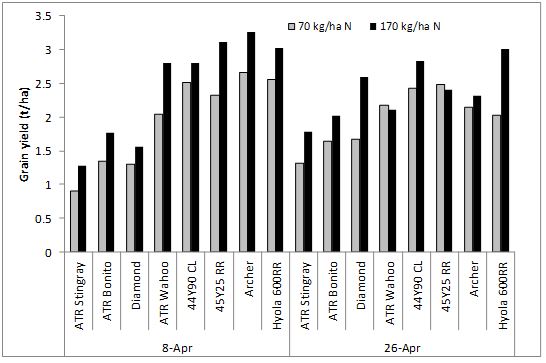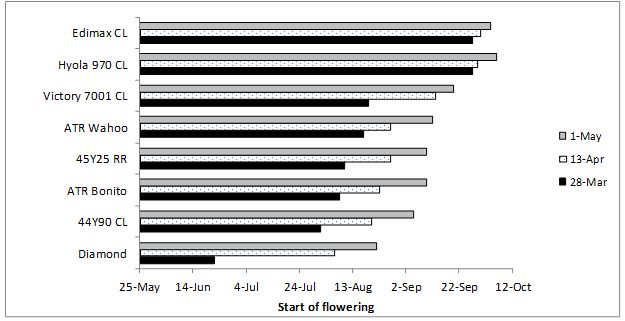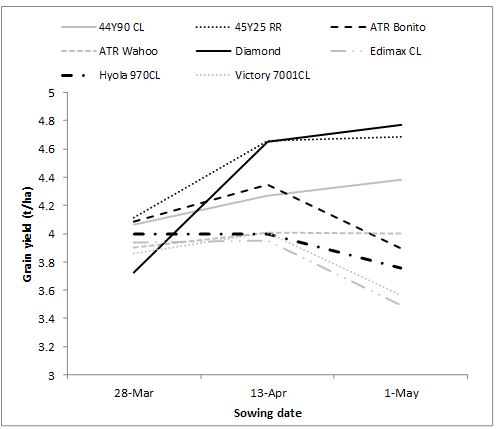Canola - well executed agronomy still makes a difference in a tough 2017
Author: Rohan Brill, Ian Menz, Daryl Reardon, Danielle Malcolm, Don McCaffery, Colin McMaster (NSW DPI) John Kirkegaard and Julianne Lilley (CSIRO Canberra). | Date: 13 Feb 2018
Take home messages
- In 2017, low yielding, unprofitable canola crops grew near profitable crops where strict attention to the system and timely agronomic management occurred.
- Matching the phenology of a variety with sowing date was paramount for grain yield, largely avoiding major frost damage. At all sites, yield was reduced when flowering started before August.
- Canola responded well to high rates of nitrogen (N) at moderate yield levels (2.0t/ha), even in a dry and frosty year.
- Hybrid canola generally outperformed open-pollinated (OP) canola especially in 2017, but sound agronomic management must accompany hybrids to maximise return on investment.
- In high yielding environments, highest yield (above 3t/ha) resulted from planting fast (e.g. Nuseed Diamond) and mid varieties (e.g. Pioneer® 45Y25 (RR) and Pioneer® 44Y90 (CL) but the very slow winter varieties still had profitable yields when planted in late March or mid-April as grain only crops.
Introduction
In the western cropping region of southern NSW (west of Wagga Wagga), extreme weather conditions experienced in 2017 made it difficult to grow profitable canola, yet there were crops that were profitable with grain yield of 1.0 to 2.0t/ha even in the same landscape where many crops yielded less than 0.5t/ha. In the eastern half of southern NSW, although much drier than average in 2017, canola yielded close to average with some exceptional results on the upper slopes.
There were consistent messages coming from the crops that were profitable in 2017, including:
- Strict fallow weed control that conserved soil moisture from the very wet spring in 2016.
- Even straw spread at 2016 harvest and prudent stubble grazing management to reduce seedbed moisture loss in autumn, and cover maintained at least until sowing.
- Selection of paddocks with relatively high starting soil water and N.
- Matching phenology and sowing date to minimise environmental stresses and optimise growth.
- Sowing hybrid canola varieties (although this alone did not guarantee success).
- Application of sufficient N to match grain yield potential.
- Some element of luck e.g. timely rainfall for establishment and high elevation that reduced frost damage.
This paper will cover research that particularly focused on points 4 to 6 above, the agronomic management of the crop. The research reported here comes from two projects:
- Optimised Canola Profitability (OCP) – a collaboration between NSW DPI, CSIRO, SARDI and GRDC, extending from southern Queensland to the Eyre Peninsula in SA.
- High Yielding Canola (HYC) – a project funded under the new Grains and Pathology Partnership between NSW DPI and GRDC. This project is based in southern NSW with sites in the South West Slopes and in the Murrumbidgee Irrigation Area.
2017 research
The site details of the three experimental sites in southern NSW are summarised in Table 1.
Table 1. Location, fallow rainfall (1 Nov to 31 March), in-crop rainfall (1 April to 31 October) and soil nitrogen (N) at sowing at three canola experimental sites in 2017.
Location | Region | Nov 16-Mar 17 Rainfall | Apr 17-Oct 17 Rainfall | Available N (sowing) |
|---|---|---|---|---|
Condobolin | CW Plains | 313mm | 122mm* | 77kg/ha |
Ganmain | Riverina | 180mm | 190mm | 123kg/ha |
Wallendbeen | SW Slopes | 228mm | 279mm | 187kg/ha |
* 25mm of irrigation applied across whole site at Condobolin on 8-March to stimulate weeds and 15 mm applied on 13-April to ensure even establishment. CW=Central West, SW=South West.
Condobolin
The experiment at Condobolin was designed to determine the optimum sowing date, plant type, phenology and N management to optimise biomass accumulation, harvest index and ultimately grain yield under two contrasting scenarios, irrigated versus dryland. Four varieties were sown in a full factorial combination of sowing date, N rate and irrigation (Table 2). The extreme frost events of 2017 did have a large impact on the outcome (major frosts on 1 July (-6.8°C), 2 July (-5.5°C), 12 July (-4.0°C), 22 July (-5.1°C), 29 July (-4.1°C), 20 August (-4.5°C), 29 August (-5.3°C) and 1 September (-3.9°C)), but success under these circumstances was still influenced by manageable factors.
Table 2. Varieties (four), sowing dates (two), nitrogen rates (two), and irrigation treatments (two) applied in a factorial combination in an agronomy experiment at Condobolin, 2017.
Variety | Sowing date | Nitrogen Rate1 | Irrigation2 |
|---|---|---|---|
Archer (slow hybrid Clearfield® (CL)) | 6-Apr | 50 kg/ha | Nil (dryland) |
Diamond (fast hybrid Conventional) | 20-Apr | 150 kg/ha | 150 mm (irrigated) |
ATR Wahoo (mid-slow Ooen Pollenated (OP) triazine tolerant (TT)) | - | - | - |
ATR Stingray (fast OP TT) | - | - | - |
1All plots had 50kg/ha N broadcast as urea before sowing. An extra 100kg/ha of N was applied as urea for the 150kg/ha treatment at 6-8 leaf stage.
2Two irrigations of 30mm were applied to the irrigated treatment in March prior to sowing, one irrigation of 30mm applied 20 June and four irrigations of 15mm applied on 15 August, 1 September, 5 September and 20 September.
From the early (6 April) sowing, the fast varieties Nuseed Diamond and ATR Stingray started flowering in late June/early July (Table 3), whereas the slower varieties Archer and ATR Wahoo flowered over a month later, starting in August. From the 20 April sowing, Nuseed Diamond and ATR Stingray flowered about two weeks earlier than Archer and ATR Wahoo sown on 6 April. Irrigation and the high N rate both delayed the start of flowering by 3 to 4 days.
Table 3. Start of flowering (50% of plants with one open flower) of four canola varieties sown at two sowing dates at Condobolin, 2017.
Variety | 6 April | 20 April |
|---|---|---|
Diamond | 28 June | 18 July |
ATR Stingray | 5 July | 23 July |
ATR Wahoo | 6 August | 16 August |
Archer | 9 August | 18 August |
The mid-slow variety ATR Wahoo and the slow variety Archer both yielded around 1t/ha in the dryland early sown treatment as their delayed flowering meant they were not too far advanced through podding when the severe frost occurred (although some frost damage would have been incurred) (Figure 1). The yield of both Archer and ATR Wahoo was reduced by sowing later as flowering was delayed and pod development was limited by elevated spring temperatures. The faster varieties Nuseed Diamond and ATR Stingray were heavily penalised by frost at both sowing dates as flowering started (from both sowing dates) by mid-winter and were heavily penalised by the frost events in 2017. For these fast varieties it would be recommended not to sow before 25 April in most environments of southern NSW.
Figure 1. Grain yield of four canola varieties sown at two sowing dates, with (irrigated) or without (dryland) irrigation, at Condobolin in 2017 (l.s.d. P<0.05 = 0.26t/ha).
Irrigation (150mm total) doubled the average experimental yield from 0.64t/ha to 1.28t/ha (Figure 1). The increase in grain yield of the fast varieties from irrigation highlights the level of recovery that can be achieved by canola despite frost damage where sufficient soil water is available. While the main message of this experiment is that varietal phenology and sowing date need to be matched to avoid very early flowering of canola (before August at this site), extra water can help frosted canola recover. The main ways that growers can reliably provide extra water to their crops is through strict fallow management and crop sequence decisions such as utilising pulses and long fallow in lower rainfall environments that may leave behind some deeper soil water.
Despite the relatively low starting soil N level (77kg/ha) at the Condobolin site, there was no response to increasing N rate from 50 to 150kg/ha in either the irrigated or dryland treatment.
Ganmain
Similar to Condobolin, there were many severe frost events at Ganmain in 2017 (Figure 2) including 1 July (-5.5°C), 2-July (-4.1°C), 22 July (-3.5°C), 20 August (-3.4°C), 26 August (-3.1°C), 28 August (-4.4°C), 29 August (-5.7°C), 30 August (-3.5°C) and 17 September (-4.6°C). Rainfall was also well below average and there was a heat event of 36.3°C on 23 September (giving a temperature range of 40.9°C in less than one week!). Despite the extreme climatic conditions in 2017, average grain yield of the trial (2.1t/ha) was still close to average for the region (1.8t/ha to 2t/ha) due to deep stored water from spring rainfall in 2016.
Figure 2. Temperature (°C) from 1 April to 31 October at the Ganmain experimental site, 10km north of Ganmain, NSW.
In this experiment (Figure 3), increased yield came from sowing varieties in their optimum window to achieve the optimum flowering date (early August) and where they were well fertilised with N. The fast varieties (Nuseed Diamond and ATR Stingray) were heavily penalised by frost from early sowing (early flowering, see flowering dates in Figure 4) and the slower varieties (e.g. Archer and ATR Wahoo) had reduced yield from later sowing as flowering occurred later (late August) than optimal and pod development was limited by rising spring temperatures. Importantly the N response increased for varieties sown in their correct window; for example there was a strong response to N with Archer, Pioneer® 45Y25 RR and ATR Wahoo sown early (flowering in early August) but minimal response when sown later (flowering in later August). Conversely there was a strong response to N for Nuseed Diamond when sown later (flowering in early August) but not where it was sown early (flowering in early July). Both Pioneer® 44Y90 CL and Hyola 600RR responded well to N at both sowing dates (Figure 3).
There was an overall benefit of planting hybrid varieties; however varietal choice was less important than ensuring sowing date, phenology and N management were optimised. For example, the OP (TT) variety ATR Wahoo (2.8t/ha) sown early with a high rate of N yielded 0.7t/ha above the trial mean yield of 2.1t/ha, whereas there were several treatments where hybrids with inappropriate management yielded less than the trial mean.
Figure 3. Grain yield of eight canola varieties sown at two sowing dates and fertilised at two nitrogen rates at Ganmain, 2017 (l.s.d. P<0.05 = 0.38t/ha).
A frost scoring system was developed for Ganmain where the number of viable seeds was counted in 20 pods on the main stem in each plot. There was a strong relationship between flowering date and the number of viable seeds per pod (Figure 4). Early sown Nuseed Diamond and ATR Stingray flowered in early July and both averaged less than six seeds per pod. From the same sowing date, Archer and ATR Wahoo delayed their flowering until early-mid August and both had more than ten viable seeds per pod. This scoring gave an insight into the level of frost damage in each variety but did not completely relate to grain yield as there were differences in the ability to compensate (with new pods) from frost damage.
There were differences in the severity of frost damage amongst varieties that flowered at a similar time, e.g. Pioneer® 44Y90 (CL) appeared to suffer less frost damage than ATR Bonito despite both flowering in early August. This might be partly explained by Pioneer® 44Y90 (CL) having more pods on the main stem (data not shown) so some of the pods on the upper parts of the main stem could have developed later and potentially avoided frost damage. In addition the higher N rate increased the number of viable seeds per pod; however this may have been partly a result of higher rates of N generally delaying phenology of canola.
Figure 4. Viable seeds per pod (columns) and flowering date (× and Δ) of eight canola varieties sown at two sowing dates (averaged across N rates) at Ganmain, 2017 (Viable seeds/pod l.s.d. P<0.05 = 2.1)
Wallendbeen
An experiment was sown at Wallendbeen to determine the ideal canola plant type for high yielding environments, aiming to compare long season varieties sown early with fast varieties sown later. Growing season rainfall was approximately 100mm below average but grain yields were still high due to the long cool spring and high elevation (530m). Soil N at sowing was 187kg/ha and combined with the application of 150kg/ha N during the growing season (114kg/ha at sowing plus 46kg/ha on 4 July) and potential mineralisation of 60kg/ha, total available N was 397kg/ha. Early sown Nuseed Diamond (28 March) started flowering 22 June (Figure 5) and had only 30% viable seeds on the main stem while most other treatments were largely unaffected by frost. The slow spring varieties Victory 7001CL and ATR Wahoo delayed their flowering until mid-August from a late March sowing while the winter varieties Hyola® 970CL and Edimax CL both flowered in a narrow window in late September to early October.
Figure 5. Start of flowering date (50% of plants with one open flower) of eight canola varieties sown at three sowing dates, Wallendbeen 2017.
The early sown Nuseed Diamond treatment that flowered on 22 June was penalised by frost and yielded 3.7t/ha but when sown on 1 May was the highest yielding treatment in the experiment at 4.8t/ha (Figure 6). Pioneer 45Y25 (RR) was the most consistently high yielding variety across the experiment but it also yielded more at the two later sowing dates than at the early sowing date. The winter varieties Hyola® 970CL and Edimax CL (both ungrazed) as well as the slow spring varieties Victory 7001CL and ATR Wahoo were the four lowest yielding varieties in the experiment, but yielded consistently across all sowing dates.
Figure 6. Grain yield of eight canola varieties sown at three sowing dates at Wallendbeen, 2017 (l.s.d. P<0.05 = 0.39t/ha).
Conclusion
Although in many regions 2017 was a tough year for growing canola, there were still profitable crops grown in most environments through effective management and in some cases a little luck (from timely rainfall) and elevation. The correct matching of sowing date with phenology is the main message from 2017, reaffirming a consistent message from recent years of canola research.
Secondly, to achieve high yield, managing the crop with optimum N fertility and finally with the former two manageable factors in place, hybrid varieties can take grain yield to the next level — but won’t be a silver bullet in isolation.
Although frost had a major impact on grain yield in 2017, especially in western areas, there were management decisions that significantly affected how the crops recovered after frost. Matching sowing date and phenology so that crops flowered in the optimum window ensured that crops were not too far advanced through pod set when the frosts hit but also not so late that yield was limited by rising spring temperatures. Hybrids tended to recover better from frost damage (which requires further investigation) but it was still possible to achieve profitable yields with OP varieties.
As well as the in-crop agronomic management factors, pre-crop management had a major bearing on outcomes for canola in 2017. Management of points 1 to 3 from the introduction including strict fallow and stubble management plus selecting the most suitable paddock for canola were critical for canola success in 2017 and need to be done well to get the best out of the agronomic management of canola.
Acknowledgements
The projects supporting this research are co-investment from GRDC, NSW DPI, CSIRO and SARDI. The research undertaken as part of this project is made possible by the significant contributions of growers through both trial cooperation and the support of the GRDC — the authors would like to thank them for their continued support.
Particularly, the authors would like to thank the grower trial co-operators for the 2017 trials; Cameron Hazlett (Wallendbeen) and Dennis and Dianne Brill (Ganmain). Thanks also to technical staff for assistance including John Bromfield, Warren Bartlett, Sharni Hands and Sophie Prentice.
Further Reading
Contact details
Rohan Brill
Wagga Wagga Agricultural Institute
02 6938 1989
rohan.brill@dpi.nsw.gov.au
Was this page helpful?
YOUR FEEDBACK






